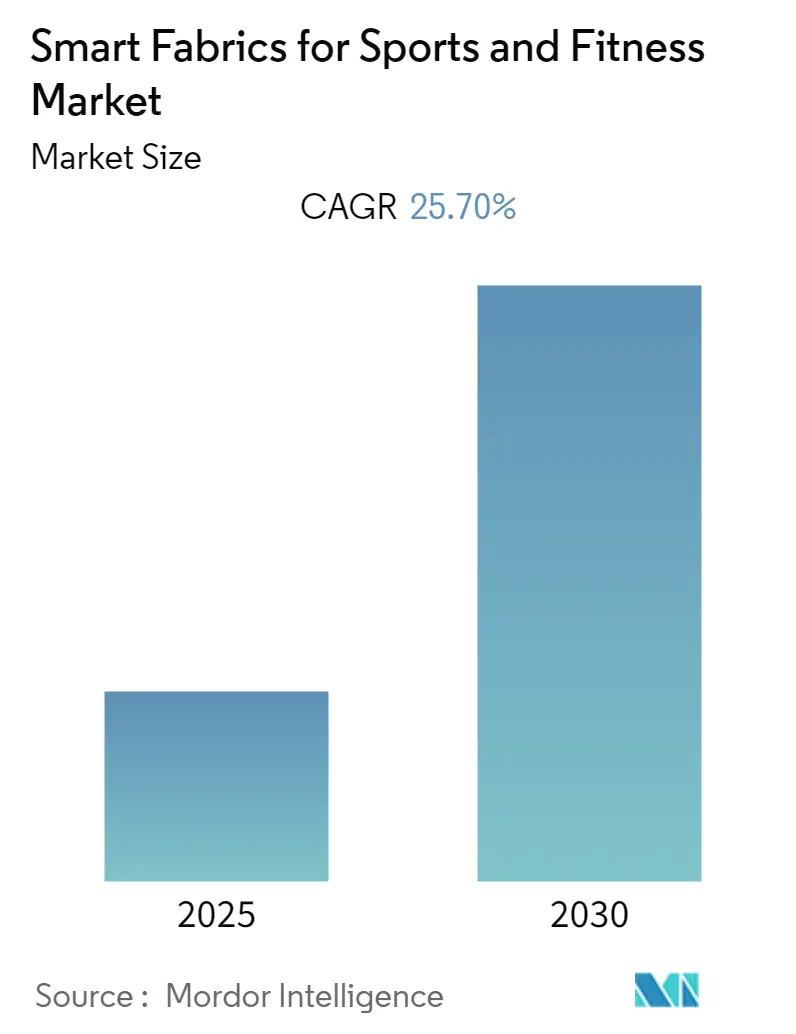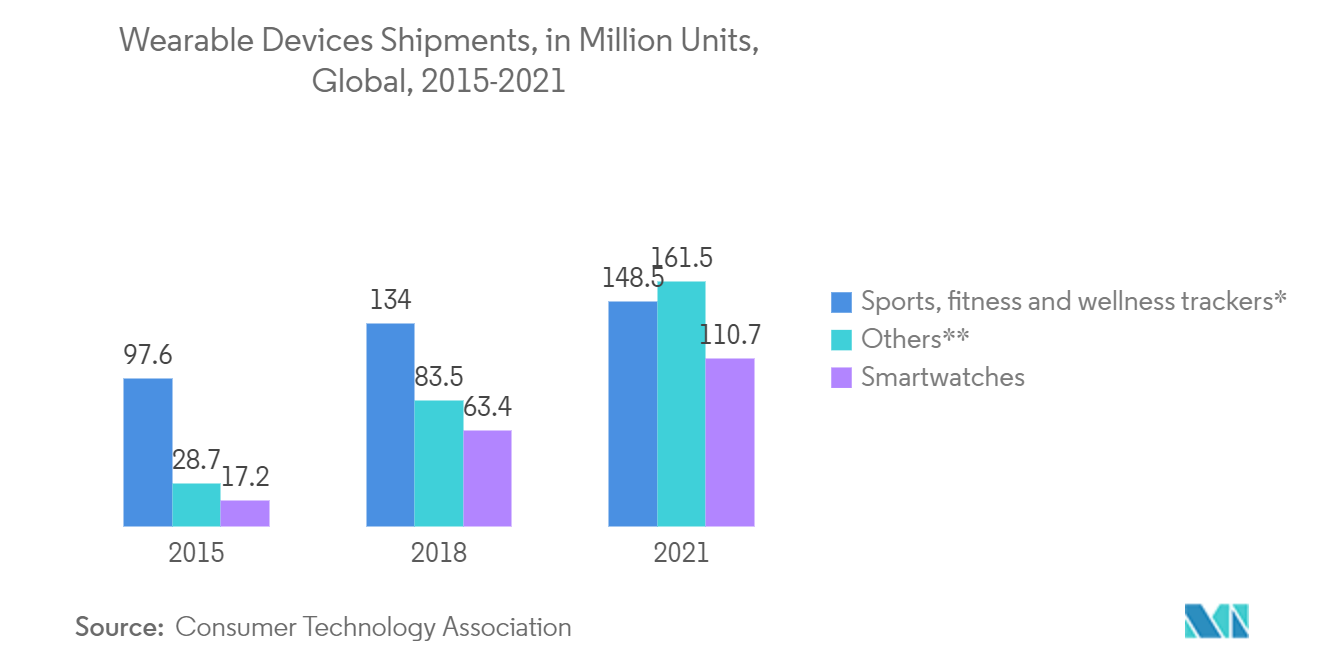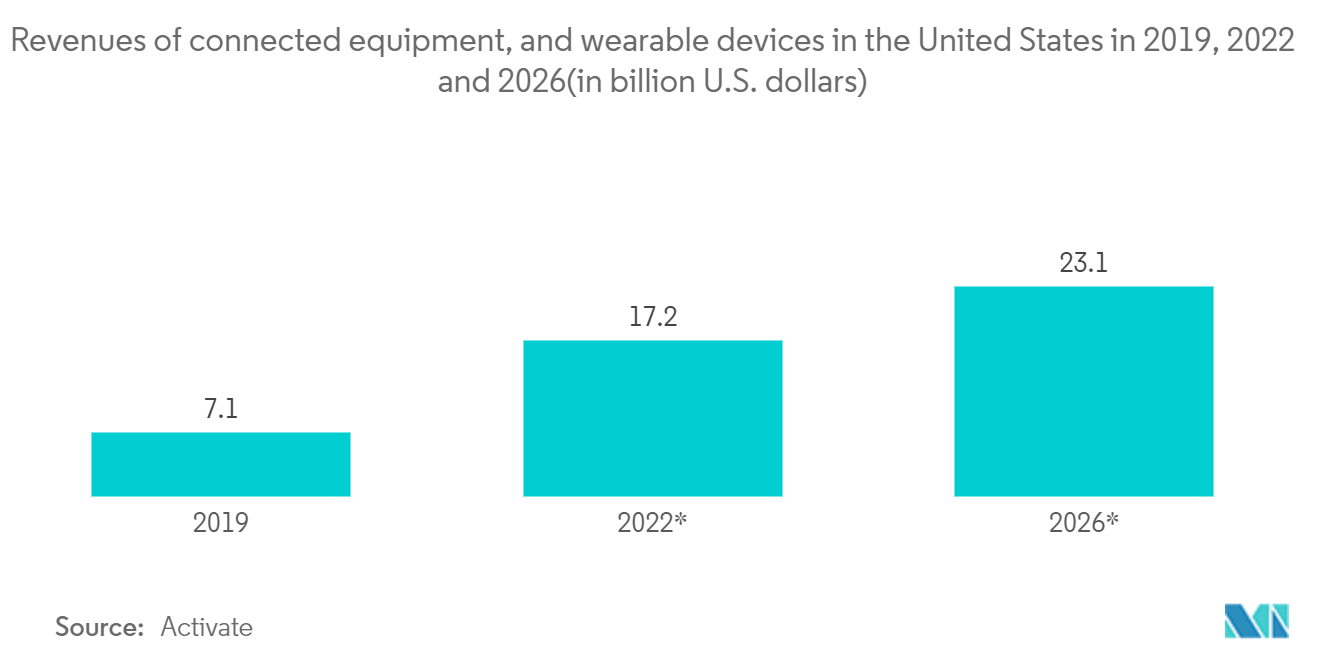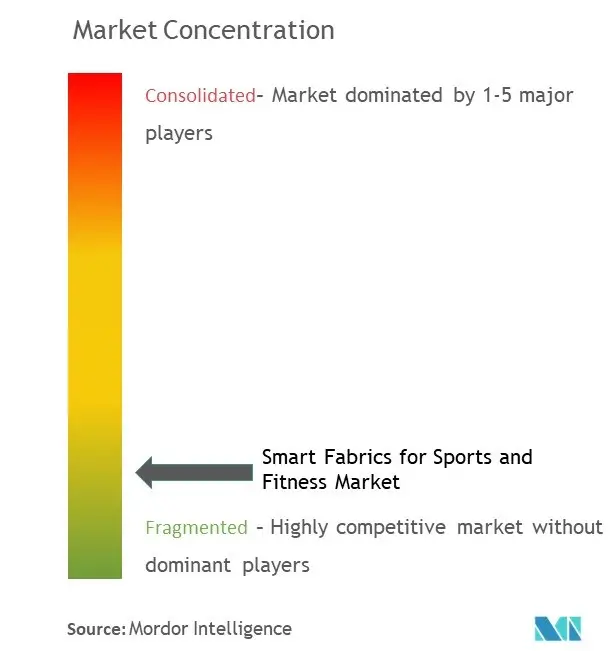Smart Fabrics for Sports & Fitness Market Analysis
The Smart Fabrics for Sports and Fitness Market is expected to register a CAGR of 25.7% during the forecast period.
- The recent technological advancements in the microelectronics industry have resulted in developing components scaled down to Nano-scale. These advancements are expected to boost the growth of smart fabrics for the sports and fitness market over the forecast period.
- Major companies have been researching smart fabrics for new possibilities to incorporate fabrics or textiles with emerging technologies, to improve the consumer's lifestyle. For instance, in July last year, Microsoft designed smart fabric with object and gesture detection. Layers of interconnected sensors that can identify an object or motion are woven into the fabric. It can take data from the smart fabric, process it, and transmit it.
- Smart Clothing has witnessed increasing applications in the Sports industry. The German men's national soccer team wears smart tech clothing in the form of jerseys by Adidas that track a wide range of information during the team's games and exercises. Mentors use speed, pulse, and distance metrics to plan future training and create a game strategy.
- An extended period of usage is an important consideration when purchasing smart clothing since it is fitted with electronics that must be durable. At the same time, the fabric must be stretchy and able to wash without damaging the electronics.
- Due to the novel COVID-19 outbreak, the market may not see significant growth, as smart fabric manufacturing requires a high level of automation and advances in textile processing techniques (such as electronic controlling systems, computer-aided design, automated inspection, automated material handling devices, numerical control machine tool, statistical process control, production planning/inventory management software, and pick/place robots).
Smart Fabrics for Sports & Fitness Market Trends
Miniaturisation of Electronic Components is Expected to Drive the Market
- The market growth is the trend of the miniaturization of electronics and the increasing integration of smart textiles with wearable devices. Smart fabrics are rapidly being employed in the healthcare and sports industries to detect muscle vibrations, control body temperatures, and give protection from numerous threats.
- With the ongoing technological advancements in nanotechnology and micro-fabrication technologies, miniaturization has been enabled in various electronic components, making small and cost-effective components, like smart sensors, which drive the smart fabrics for sports and fitness.
- For instance, Leibniz Institute of Photonic Technology (IPHT) researchers in Jena, Germany, is working to create a self-sufficient energy source based on textiles. Doing this would make it increasingly simpler to power mobile electronics worn near the body without access to an external power source.
- The 3-D printing production processes and the production of nano-materials by nano-dimension solutions have the potential to resolve any production challenges. They will also help create an efficient production technology for smart fabrics.
- Various institutes have also been investing in research activities to increase applications for smart clothing. For instance, MIT has created a lightweight sensor that can be embedded into flexible fabrics, including polyesters typically used in athletic wear, to monitor vital signs, including body temperature, heart rate, and respiratory rate. The sensors are machine-washable and can be integrated into clothing that can be removed and reused in different garments. The sensor has potential applications across the health industry, athletics, and astronaut vital sign monitoring. NASA and MIT Media Lab Space Exploration Initiative partially funded MIT research.
- The emerging new segment of wearable devices, the E-textile or smart fabrics segment, has changed how these devices are worn. Smart fabrics incorporate biometric sensors, minicomputers, circuits, or metallic yarns for different functionality. These fabrics can be customized accordingly to meet almost all the requirements of a sports athlete or any fitness buff.
North America is Expected to Hold the Highest Market Share
- The increasing fitness demand will lead to smart fabric growth in North America's consumer products sector. Additionally, the US-based companies' increasing developments and innovations have contributed most significantly to the region's market and, specifically, in the United States, resulting in a significant increase in the usage of Smart fabric.
- The Industrial Fabrics Association International (IFAI) held a summit in March last year. Among the key conclusions made at the summit were to increase overall investment in emerging smart fabric technologies and emphasize collaboration between market competitors as critical drivers of smart technologies' growth.
- The factors influencing the North American market include major market players, portable and comfortable usage, expanded healthcare awareness, the hovering fee of manufacturing, and technological progressions. These vital elements have advocated the adoption of smart fabric for sports in the region.
- Furthermore, compression garments made with technology-enhanced smart sports cloth are designed to assist circulation and muscle rehabilitation. Today, various other data types can be collected, including heart-rate electrocardiogram (ECG) signals and electromyography (EMG) for monitoring body muscle activity. Precise body temperature monitoring may assess a wearer's fitness and safeguard them from the adverse effects of excessive exercise.
- In April last year, the Natural Sciences and Engineering Research Council of Canada (NSERC) awarded Centennial College and its partners USD 4 million in multi-year funding to develop products for the global e-textile market and to assist small and medium-sized enterprises (SMEs) in the transportation, food production, energy, and advanced manufacturing sectors. E-textiles incorporated digital components into fabrics, such as biometric sensors, minicomputers, and electronics, providing them with new data collecting, energy transfer, and communication capabilities. E-textiles could monitor and communicate health data to advise therapy, allowing for virtual care outside of hospital settings, which would benefit the elderly and persons with chronic illnesses or disabilities.
Smart Fabrics for Sports & Fitness Industry Overview
The smart fabrics for the sports and fitness market is highly competitive due to the presence of many small and large players. The major players are Nike Inc., AiQ, Adidas AG, Smartex SRL, and Koninklijke Ten Cate NV, among others. The start-ups are also investing in Smart materials for sports and fitness to introduce new technology.
- June 2022 - Nextiles, a smart fabric technology business, raised USD 5 million in a seed fundraising round that was oversubscribed, allowing it to create technologies that might generate new data streams for performance analytics. Madison Square Garden Sports Corp, Alumni Ventures, SmartSports, Phoenix Capital Ventures, and New lab were among the investors in the round led by DraftKings' venture capital arm, Drive by DraftKings. Hilary Knight, a three-time Olympic ice hockey medalist, is also an investor, as is the NBA, which includes Nextiles in its inaugural Launchpad incubation project earlier this year.
- January 2022 - Pyratex Start-up in Spain raised EUR 600,000 (USD 680,086) in the second round of fundraising, including Asics Corporation's investment arm as one of the investors. Pyratex said the funds would improve its brand and increase customer awareness, focusing on continuing to invest in R&D to extend its line of functional and natural fabrics.
Smart Fabrics for Sports & Fitness Market Leaders
-
AiQ Smart Clothing
-
Eeonyx Corporation
-
Interactive Wear AG
-
Koninklijke Ten Cate NV
-
Performance Fibers (Indorama)
- *Disclaimer: Major Players sorted in no particular order
Smart Fabrics for Sports & Fitness Market News
- February 2022 - The Indian Institute of Technology (IIT) Delhi has signed an agreement with Troop Comforts Limited (TCL), a Government of India firm, to create Smart Protective Clothing for Indian security forces.
- April 2022 - The School of Mechanical, Electrical and Manufacturing Engineering (MEME) and a team of researchers at the University of Moratuwa (Sri Lanka), the lightweight and thin TENG cloth produced over 35V of voltage utilizing modest artificial motions, according to tech specialists. It has the potential to power low-power health monitors, environmental sensors, and electrical gadgets.
- May 2022 - Chinese scientists developed a kind of smart clothing that is capable of monitoring physiological signals. They incorporate fiber mechanical sensors into traditional clothing to make a wearable health monitoring device. The Beijing Institute of Technology research teams and Northwestern Polytechnical University in China jointly developed smart clothes.
- July 2022 - Microsoft developed a smart fabric that detects objects and gestures. Layer networked sensors embedded in the material can detect an object or motion. And it's more than simply a few sensors sewed in. The patent also describes the creation of data processing circuitry. It can receive, process, and transmit data from the smart fabric.
Smart Fabrics for Sports & Fitness Industry Segmentation
Biometric sensors, minicomputers, circuits, or metallic yarns are all incorporated into innovative fabrics for various functionalities. These materials can be tailored to practically any sports athlete or fitness enthusiast's requirement.
The Smart Fabrics for Sports and Fitness Market is Segmented by Product Type (Ultra-smart Fabric, Active Smart Fabric, Passive Smart Fabric), by Function (Energy Harvesting, Sensing, Thermoelectricity Luminescent), and by Geography (North America (United States, Canada), Europe (Germany, UK, France, Spain, and Rest of Europe), Asia Pacific (China, Japan, India, Australia, and Rest of Asia-Pacific), and Latin America (Brazil, Mexico, Argentina, and Rest of Latin America), and Middle East & Africa (UAE, Saudi Arabia, South Africa, and Rest of MEA).
The market sizes and forecasts are provided in terms of value (USD million) for all the above segments.
| By Product Type | Ultra-smart Fabric | ||
| Active Smart Fabric | |||
| Passive Smart Fabric | |||
| By Function | Energy Harvesting | ||
| Sensing | |||
| Thermoelectricity | |||
| Luminescent | |||
| Other Functions | |||
| Geography | North America | United States | |
| Canada | |||
| Europe | Germany | ||
| UK | |||
| France | |||
| Spain | |||
| Rest of Europe | |||
| Asia-Pacific | China | ||
| Japan | |||
| India | |||
| Australia | |||
| Rest of Asia-Pacific | |||
| Latin America | Brazil | ||
| Mexico | |||
| Argentina | |||
| Rest of Latin America | |||
| Middle East and Africa | UAE | ||
| Saudi Arabia | |||
| South Africa | |||
| Rest of Middle East and Africa | |||
Smart Fabrics for Sports & Fitness Market Research FAQs
What is the current Smart Fabrics for Sports and Fitness Market size?
The Smart Fabrics for Sports and Fitness Market is projected to register a CAGR of 25.7% during the forecast period (2025-2030)
Who are the key players in Smart Fabrics for Sports and Fitness Market?
AiQ Smart Clothing, Eeonyx Corporation, Interactive Wear AG, Koninklijke Ten Cate NV and Performance Fibers (Indorama) are the major companies operating in the Smart Fabrics for Sports and Fitness Market.
Which is the fastest growing region in Smart Fabrics for Sports and Fitness Market?
Asia Pacific is estimated to grow at the highest CAGR over the forecast period (2025-2030).
Which region has the biggest share in Smart Fabrics for Sports and Fitness Market?
In 2025, the North America accounts for the largest market share in Smart Fabrics for Sports and Fitness Market.
What years does this Smart Fabrics for Sports and Fitness Market cover?
The report covers the Smart Fabrics for Sports and Fitness Market historical market size for years: 2019, 2020, 2021, 2022, 2023 and 2024. The report also forecasts the Smart Fabrics for Sports and Fitness Market size for years: 2025, 2026, 2027, 2028, 2029 and 2030.
Our Best Selling Reports
Smart Fabrics for Sports and Fitness Industry Report
Statistics for the 2025 Smart Fabrics for Sports and Fitness market share, size and revenue growth rate, created by Mordor Intelligence™ Industry Reports. Smart Fabrics for Sports and Fitness analysis includes a market forecast outlook for 2025 to 2030 and historical overview. Get a sample of this industry analysis as a free report PDF download.







